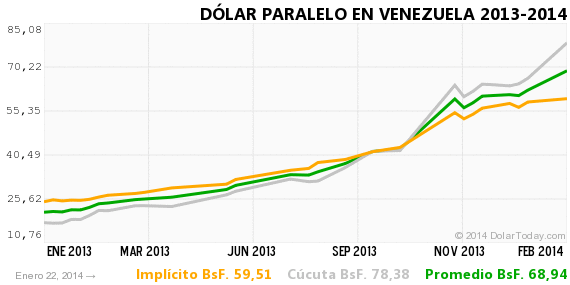– Venezuela Devalues Bolivar By Another 44% For Some, Still 600% Higher Than Black Market Due To 50% Inflation (ZeroHedge, Jan 22, 2014):
Less than a year ago, Venezuela shocked the world when it launched the “first nuke” in the ongoing currency wars (which despite having dropped off the front pages, have certainly not ended), by devaluing its currency, the Bolivar from 4.30 to the USD to 6.30, in the process crushing the profits of many companies that operate(d) in the TP-deprived socialist paradise (which as we reported earlier is about to experience food shortages).
Earlier today, Venezuela Oil Minister and Economy Vice President Rafael Ramirez announced on state television that the country just devalued the official Bolivar exchange rate again by another whopping 45%, for some.
Specifically, Venezuelans traveling abroad and airlines will use Sicad FX rate which was last 11.36 bolivars per dollar. Those spared from the most recent devaluation, for now, are students abroad, pensioners, retirees, consular and diplomatic services who will continue using 6.3 bolivars/USD rate. This follows comparable steps taken in late December, when the Bolivar was devalued by the same amount for any non-residents and tourists entering the nation, as the nation unrolled its centrally-planned currency regime in which the Bolivar is offered through a dollar-auction system called Sicad.
The WSJ reported at the time:
Venezuela earlier this year launched a dollar-auction system called Sicad where some importers and tourists could request hard currency at a rate weaker than the official exchange rate of 6.3 bolívares. The government never formally disclosed the exchange rate used in Sicad but local analysts and companies that have participated in the auctions say the rate is close to 12 bolívares per dollar.
Venezuela will increase usage of Sicad in 2014 and will deliver $5 billion into the local economy through the system, according to Mr. Ramirez.
Still, Wall Street analysts widely expect Venezuela to pull off a full-scale devaluation of its currency in the near-term, a move that would help the government shore up a its finances by capturing more in local-currency terms when it converts dollars earned through oil sales.
Indeed, the reason why today’s move is largely meaningless and purely optical, is because there is still an 85% differential between the official rate, and what one can get for a dollar on the black market. Which as the chart below shows is substantially higher, and at last check was 78.38 Bolivars per dollar. Said otherwise, the brand new official exchange rate, which will soon be implemented for everyone, is still 590% higher than the real clearing price of the currency on the black market.
Curious why the currency is crashing so fast? Perhaps ask the 50% (and rising) annual inflation in the socialist paradise.
WSJ chimes in again:
“This new tourist rate is not as compelling as the black market, but it does represent a step in the right direction,” Russ Dallen, a partner at Caracas Capital Markets, said in a note to clients.
“For my colleagues on Wall Street that come down to Venezuela, now supposedly when you use your U.S. credit cards for expenses, you will get billed at this 11.3 rate, not the 6.3 rate,” Mr. Dallen added.
Sadly, for a government seeking to refill its coffers with much needed dollars in order to avoid what soon may be starvation as food distributors don’t have dollars with which to pay their vendors, it will have to be far more generous in what it offers those who have the greenback, instead of continuing to encourage the use of the black market, where the money is simply hoarded by enterprising members of the population.
Oh, and for those confused, the reason why the Caracas stock exchange is the best performing stock market in the world in the past year…
… The answer is simple: follow the gray line showing the true “value” of the Bolivar.


